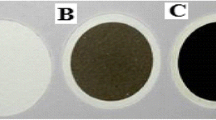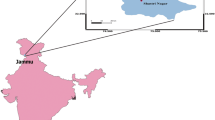Abstract
Measurements of fine (PM2.5) and inhalable (PM10) particles were collected at the Alaknanda Valley in the heart of Garhwal region during December 2015–December 2016. Collected samples of PMs were analyzed for major chemical species as anions (F−, Cl−, SO42−, NO2− and NO3−) and cations (Na+, NH4+, K+, Ca2+ and Mg2+) by ion chromatography. During the study period, the concentrations of PM2.5 and PM10 were 78.7 ± 25.1 and 111.8 ± 23.4 μg m−3, respectively. The measured chemical species were found a large variability in different seasons due to the impact of emissions and meteorological parameters. The measured water-soluble (WS) chemical species of PM2.5 and PM10 were 43% (33.7 μg m−3) and 57% (64.2 μg m−3), respectively, with the highest concentrations during the winter season followed by summer, monsoon and post-monsoon seasons. A significant positive correlation was observed between NH4+ and other species (Cl−, SO42− and NO3−) in both PM2.5 and PM10, which indicates its presence in the atmosphere as ammonium salts. As a result, NH4+ play a crucial role in neutralization of acidic species in the winter season; however, the contrary feature was observed in the summer season where Ca2+ was responsible for the main neutralizing species, mainly transported from the inland region during the summer. Principal component analysis shows that secondary aerosol, biomass burning, and soil-driven dust were the possible sources of the measured species over the station. Further, air mass back trajectory analyses indicate that the highest mass concentrations of PMs and WS chemical species were in the post-monsoon season when the air masses pass from eastern Pakistan and western part of India over receptor site. In the winter season, the concentrations of PMs and WS species were highest (second) when the air masses transported from a long distance up to Southern Afghanistan covering with Pakistan and western part of India. In overall, the study suggests the long-range transport of pollutants plays a crucial role in the enhancement of PMs over Alaknanda valley region.







Similar content being viewed by others
References
Akimoto H (2003) Global air quality and pollution. Science 302:1716–1719
Andreae MO (1995) Climatic effects of changing atmospheric aerosol levels. In: Henderson-Sellers A (ed) world survey of climatology: future climates of the world, vol 16. Elsevier, Amsterdam, pp 341–392
Ashish A, Joshi V, Sharma A, Anthwal S (2006) Retreat of Himalayan glaciers indicator of climate change. Nat Sci 4:53–60
Beegum SN, Moorthy KK, Babu SS, Satheesh SK, Vinoj V, Badarinath KVS, Safai PD, Devara PCS, Singh S, Vinod Dumka UC, Pant P (2009) Spatial distribution of aerosol black carbon over India during pre-monsoon season. Atmos Environ 43(5):1071–1078
Bisht DS, Dumka UC, Kaskaoutis DG, Pipal AS, Srivastava AK, Soni VK, Attri SD, Sateesh M, Tiwari S (2015a) Carbonaceous aerosols and pollutants over Delhi urban environment: temporal evolution, source apportionment and radiative forcing. Sci Total Environ 521–522:431–445
Bisht DS, Srivastava AK, Pipal AS, Srivastava MK, Pandey AK, Tiwari S, Pandithurai G (2015b) Aerosol characteristics at a rural station in southern peninsular India during CAIPEEX-IGOC: physical and chemical properties. Environ Sci Pollut Res 22:5293–5304
Bisht DS, Tiwari S, Srivastava AK, Singh JV, Singh BP, Srivastava MK (2015c) High concentration of acidic species in rainwater at Varanasi in the Indo-Gangetic plains, India. Nat Hazards 75:2985–3003
Chatterjee A, Adak A, Singh AK, Srivastava MK, Ghosh SK, Tiwari S et al (2010) Aerosol chemistry over a high altitude station at northeastern Himalayas, India. PLoS One 5(6):e11122
Cheng Y, Engling G, He KB, Duan FK, Ma YL, Du ZY, Liu JM, Zheng M, Weber RJ (2013) Biomass burning contribution to Beijing aerosol. Atmos Chem Phys 13:7765–7781
Dholakia HH, Bhadra D, Garg A (2014) Short term association between ambient air pollution and mortality and modification by temperature in five Indian cities. Atmos Environ 99:168–174
Finlayson Pitts BJ, Pitts JN Jr (2000) Chemistry of the upper and lower atmosphere. Elsevier, New York
Forest Survey of India (FSI) (2009) Chapter 7: forest and tree resources in states and union territories. India State of Forest Report, Dehradun
Gabriel R, Mayol-Bracero OL, Andreae MO (2002) Chemical characterization of submicron aerosol particles collected over the Indian Ocean. J Geophys Res 107(D19):8005. https://doi.org/10.1029/2000jd000034
Gadi R, Kulshrestha UC, Sarkar AK, Garg SC, Parashar DC (2011) Emissions of SO2 and NOx from biofuels in India. Tellus B: Chem Phys Meteorol 55(3):787–795. https://doi.org/10.3402/tellusb.v55i3.16370
Gautam R, Hsu NC, Lau WKM, Yasunari TJ (2013) Satellite observations of desert dust-induced Himalayan snow darkening. Geophys Res Lett 40(5):988–993
Hobbs PV, Reid JS, Kotchenruther RA, Ferek RJ, Weiss R (1997) Direct radiative forcing by smoke from biomass burning. Science 275:1776–1778
Hong Z, Chak KC (1997) Size distribution of inorganic aerosols at a coastal site. J Aerosol Sci 28(101):213–214
IPCC (2007) Impacts, Adaptation and Vulnerability. Working group ii contribution to the intergovernmental panel on climate change. Fourth Assessment Report (Cambridge Univ Press), Cambridge
Jung CH, Lee JY, Um J, Lee SS, KIm YP (2018) Chemical composition based aerosol optical properties according to size distribution and mixture types during smog and Asian dust events in Seoul Korea. Asia Pac J Atmos Sci 54(1):19–32
Kaskaoutis DG, Kumar S, Sharma D, Singh RP, Kharol SK, Sharma M, Singh AK, Singh S, Singh A, Singh D (2014) Effects of crop residue burning on aerosol properties, plume characteristics and long, range transport over northern India. J Geophys Res 119:5424–5444
Kaya G, Tuncel G (1997) Trace element and major ion composition of wet and dry deposition in Ankara, Turkey. Atmos Environ 31:3985–3998
Kishore N, Srivastava AK, Nandan H, Pandey CP, Agrawal S, Singh N, Soni VK, Bisht DS, Tiwari S, Srivastava MK (2018) Long-term (2005–2012) measurements of near-surface air pollutants at an urban location in Indo-Gangetic Basin. J Earth Sys Sci (Accepted)
Kulshrestha UC, Sarkar AK, Srivastava SS, Parashar DC (1996) Investigation into atmospheric deposition through precipitation studies at New Delhi (India). Atmos Environ 30:4149–4154
Kumar A, Attri AK (2016) Biomass combustion a dominant source of carbonaceous aerosols in the ambient environment of western himalayas. Aerosol Air Qual Res 16:519–529
Lavanchy MG, Schotterer U, Schwikowski M, Gaggeler HW, Baltensperger U (1999) Historical record of carbonaceous particle concentrations from a European high-alpine glacier. J Geophys Res. 104:21227–21236
Li Z, Guo J, Ding A, Liao H, Liu J, Sun Y, Wang T, Xue H, Zhang H, Zhu B (2017) Air Pollution and Control Aerosol and boundary-layer interactions and impact on air quality. Natl Sci Rev 4:810–833
Mayewski PA, Jeschke PA (1979) Himalayan and Trans-Himalayan glacier fluctuations since AD 1812. Arct Alp Res 11:267–287
Menon S, Hansen J, Nazarenko L, Luo Y (2002) Climate effects of black carbon aerosols in China and India. Science 297:2250–2253
Parmar RS, Satsangi GS, Kumari M, Lakhani A, Srivastava SS, Prakash S (2001) Study of size distribution of atmospheric aerosol at Agra. Atmos Environ 35:693–702
Penner JE, Hegg D, Leaitch R (2001) Unravelling the role of aerosols in climate change. Environ Sci Technol 34:332A–340A
Pipal AS, Kulshrestha A, Taneja A (2011) Characterization and morphological analysis of airborne PM2.5 and PM10 in Agra located in north central India. Atmos Environ 45:3621–3630
Pope CA, Thun M, Namboodira J, Dockery DW, Evans JS, Speizer FW, Heath CW Jr (1995) Particulate air pollution as a predictor of mortality in a prospective study of US adults. Am J Respir Crit Care Med 151:669–674
Ram K, Sarin MM, Hegde P (2008) Atmospheric abundances of primary and secondary carbonaceous species at two high-altitude sites in India: sources and temporal variability. Atmos Environ 42:6785–6796
Ram K, Sarin MM, Hegde P (2010) Long-term record of aerosol optical properties and chemical composition from a high-altitude site (Manora Peak) in Central Himalaya. Atmos Chem Phys 10(23):11791–11803
Rastogi N, Sarin MM (2006) Chemistry of aerosols over a semi-arid region: evidence for acid neutralization by mineral dust. Geophy Res Lett 33:L23815
Safai PD, Kevat S, Praveen PS, Rao PSP, Momin GA, Ali K, Devara PCS (2007) Seasonal variation of black carbon aerosols over a tropical urban city of Pune, India. Atmos Environ 41:2699–2709
Sen A et al (2017) Variations in particulate matter over Indo-Gangetic Plains and Indo-Himalayan Range during four field campaigns in winter monsoon and summer monsoon: role of pollution pathways. Atmos Environ 154:200–224
Sharma M, Maloo S (2005) Assessment of ambient air PM10 and PM2.5 and characteristics of PM10 in the city of Kanpur, India. Atmos Environ 39:6015–6026
Sharma SK et al (2014) Measurements of particulate (PM2.5), BC and trace gases over the northwestern Himalayan Region of India. MAPAN J Metrol Soc Ind 29:243–253. https://doi.org/10.1007/s12647-014-0104-2
Sharma D, Srivastava AK, Ram K, Singh A, Singh D (2017) Temporal variability in aerosol characteristics and its radiative properties over Patiala, northwestern part of India: impact of agricultural biomass burning emissions. Environ Pollution 231:1030–1041
Srivastava AK, Sachchidanand Singh, Tiwari S, Kanawade VP, Bisht DS (2012) Variation between near-surface and columnar aerosol characteristics during the winter and summer at Delhi in the Indo-Gangetic Basin. J Atmos Solar Terrest Phys 77:57–66
Srivastava AK, Bisht DS, Ram K, Tiwari S, Srivastava MK (2014) Characterization of carbonaceous aerosols over Delhi in Ganga basin: seasonal variability and possible sources. Environ Sci Pollut Res 21:8610–8619
Srivastava AK, Ram K, Singh S, Kumar S, Tiwari S (2015) Aerosol optical properties and radiative effects over Manora Peak in the Himalayan foothills: seasonal variability and role of transported aerosols. Sci Total Environ 502:287–295
Stein AF, Draxler RR, Rolph GD, Stunder BJB, Cohen MD, Ngan F (2015) NOAA’s HYSPLIT atmospheric transport and dispersion modeling system. Bull Amer Meteor Soc 96:2059–2077. https://doi.org/10.1175/BAMS-D-14-00110.1
Tare V, Tripathi SN, Chinnam N, Srivastava AK, Dey S, Manar M, Kanawade VP, Agarwal A, Kishore S, Lal RB, Shar M (2006) Measurements of atmospheric parameters during indian space research organization geosphere biosphere program land campaign II at a typical location in the Ganga Basin: 2. Chemical properties. J Geophys Res 111(D23210):1–14
Tiwari S, Srivastava AK, Bisht DS, Bano T, Singh S, Behura S, Srivastava MK, Chate DM, Padmanabhamurty B (2009) Black carbon and chemical characteristics of PM10 and PM2.5 at an urban site of North India. J Atmos Chem 62:193–209
Tiwari S, Chate DM, Bisht DS, Srivastava MK, Padmanabhamurty B (2012) Rainwater chemistry in the North Western Himalayan Region, India. Atmos Res 104–105:128–138
Tiwari S, Pervez S, Perrino C, Srivastava AK, Bisht DS, Chate DM (2013) Chemical characterization of atmospheric Particulate Matter in Delhi, India, Part II: source apportionment studies using PMF 3.0. Sustainable. Environ Res 23(5):295–306
Tripathi SN et al (2006) Measurements of atmospheric parameters during Indian space research organization geosphere biosphere programme land campaign II at a typical location in the Ganga basin: 1. Physical and optical properties. J Geophys Res 111(D23209):1–14
Acknowledgements
Author ASG is thankful to the SERB-DST project for financial support (No. SB/EMEQ-043/2014 dated March 08, 2016). Authors are thankful to the Director, IITM to provide the facility for analysis of aerosol samples at IITM Delhi branch.
Author information
Authors and Affiliations
Corresponding author
Rights and permissions
About this article
Cite this article
Gautam, A.S., Negi, R.S., Singh, S. et al. Chemical Characteristics of Atmospheric Aerosol at Alaknanda Valley (Srinagar) in the Central Himalaya Region, India. Int J Environ Res 12, 681–691 (2018). https://doi.org/10.1007/s41742-018-0125-8
Received:
Revised:
Accepted:
Published:
Issue Date:
DOI: https://doi.org/10.1007/s41742-018-0125-8




